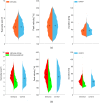Neural correlates of intra-saccadic motion perception
- PMID: 34698810
- PMCID: PMC8556557
- DOI: 10.1167/jov.21.11.19
Neural correlates of intra-saccadic motion perception
Abstract
Retinal motion of the visual scene is not consciously perceived during ocular saccades in normal everyday conditions. It has been suggested that extra-retinal signals actively suppress intra-saccadic motion perception to preserve stable perception of the visual world. However, using stimuli optimized to preferentially activate the M-pathway, Castet and Masson (2000) demonstrated that motion can be perceived during a saccade. Based on this psychophysical paradigm, we used electroencephalography and eye-tracking recordings to investigate the neural correlates related to the conscious perception of intra-saccadic motion. We demonstrated the effective involvement during saccades of the cortical areas V1-V2 and MT-V5, which convey motion information along the M-pathway. We also showed that individual motion perception was related to retinal temporal frequency.
Figures









References
-
- Bair, W., & O'Keefe, L. P. (1998). The influence of fixational eye movements on the response of neurons in area MT of the macaque. Visual Neuroscience, 15(4), 779–786. - PubMed
-
- Bahill, A. T., Clark, M. R., & Stark, L. (1975). The main sequence, a tool for studying human eye movements. Mathematical Biosciences , 24(3-4), 191–204.
-
- Baloh, R. W., Sills, A. W., Kumley, W. E., & Honrubia, V. (1975). Quantitative measurement of saccade amplitude, duration, and velocity. Neurology , 25(11), 1065–1065. - PubMed
-
- Barlow, J. S., & Cigánek, L. (1969). Lambda responses in relation to visual evoked responses in man. Electroencephalography and Clinical Neurophysiology , 26(2), 183–192. - PubMed
-
- Bell, A. J., & Sejnowski, T. J. (1995). An information-maximisation approach to blind separation and blind deconvolution. Neural Computation , 7(6), 1129–1159. - PubMed
Publication types
MeSH terms
LinkOut - more resources
Full Text Sources

